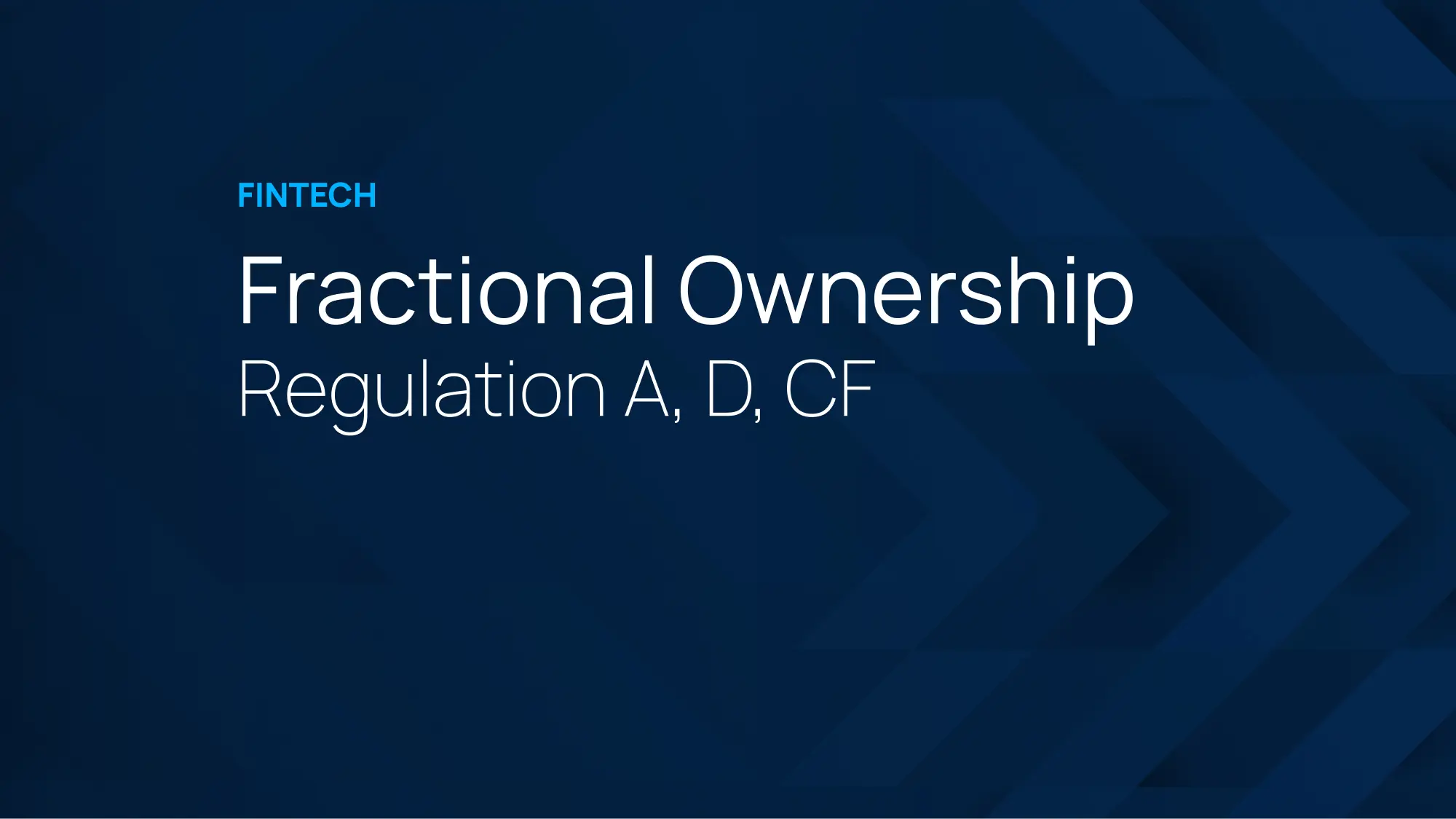
Fintech
Fractional Ownership: Regulation A, D, CF

Introduction
Scalio is an industry leader in custom fractional ownership technology. As our projects in collectibles, memorabilia, art, and even racehorses continue to grow, we decided to create a series of guides about the key aspects of fractional ownership.
This guide focuses on main three regulations related to fractional ownership. If you haven't yet, be sure to read our first post in our Fintech Blog Series, Fractional Ownership: An Introduction, where I introduce the basics of fractional ownership.

Regulation A
The increased interest in fractional investing is largely due to a United States Securities and Exchange Commission (SEC) change in 2015 to Title IV of the JOBS Act called Regulation A, known simply as “Reg A”.
Reg A is an exemption from some registration requirements. It gives companies who qualify an advantage in time and effort over companies who do not meet the requirements and must register fully. Similar to crowdfunding, this allowed almost anyone with capital to invest. Both accredited and non-accredited investors were allowed to invest in publicly owned companies. This is in contrast to most other exceptions, which generally allow only accredited investors to invest. However, non-accredited investors are not able to invest more than 10% of their annual income or net worth.
The barriers are high to become an accredited investor in the US. It’s estimated that a mere 8.25% of the US population are accredited, which means that Reg A has the potential to tap into 91.75% of the population.
For companies, Regulation A has two tiers that determine how much money can be raised:
- Tier 1: Offerings of up to $20 million in a 12-month period.
- Tier 2: Offerings of up to $75 million in a 12-month period.
- Additional requirements apply to Tier 2 offerings, including limitations on the amount of money a non-accredited investor may invest in a Tier 2 offering, requirements for audited financial statements, and the filing of ongoing reports. Issuers in Tier 2 offerings are not required to register or qualify their offerings with state securities regulators.
In summary, Reg A effectively lowered the barrier of entry for any company looking to garner investment. They can attract and advertise to everyone, and capture a much larger investor base composed of various levels of financial resources.
Regulation D
Regulation D is also an exception from many registration requirements with the SEC, and aids in the sales of securities for small businesses and startups. However, Reg D is aimed particularly at accredited investors. There are several rules under Reg D including rules 504, 505, 506(b), and 506(c). For fractional investing, 506(b) and 506(c) are the most relevant. We will cover the specifics of these rules in an upcoming article. For now, we’ll only discuss Reg D rules 506(b) and 506(c).
It’s important to note that despite their more limited population, accredited investors make up an important population of investors due to their high net worth and ability to invest large sums of money. They are considered to be experienced investors and therefore need less protection from the SEC. For this reason, there are no limits to how much money can be raised under rules 506(b) and 506(c). As a reminder, the threshold for becoming an accredited investor are:
- An individual with a net income exceeding $200,000 in each of the two most recent years or joint income with a spouse exceeding $300,000 for those years.
- An individual with a net worth, or joint net worth, with the person’s spouse, that exceeds $1 million at the time of the purchase, excluding the value of the primary residence of such person.
- Individuals who have certain professional certifications, designations, or credentials. Individuals who are “knowledgeable employees” of a private fund, and SEC and state-registered investment advisers
Therefore, Reg D is beneficial for companies that already have access to a pool of accredited investors. This can be difficult however as accredited investors have a wide range of investment opportunities.
There are several key difference between Rule 506 (b) and Rule 506 (c), including the following:
- Verification: The issuer in a Rule 506(b) offering does not need to verify whether an investor is accredited unless they believe that they are lying. However, in a Rule 506(c) offering, the issuer must verify that the investor is indeed accredited.
- Advertising: Under Rule 506(b), advertising an offering is allowed unlike under Rule 506(c), where advertising is not permitted.
In summary, Reg D is aimed primarily at accredited investors, and for that reason has no limit on how much money can be invested in a company that qualifies for rules 506(b) and 506(c).
Regulation CF
Regulation CF (also called Equity Crowdfunding or Title III Crowdfunding) is more similar to Reg A than Reg D, as it applies to accredited and non-accredited investors.
Companies can raise up to $5 million under Reg CF annually and have fewer legal obligations than Reg A or Reg D. While they are similar and both come from the JOBS Act, Reg CF is more ideal for companies who need to raise less capital. Most often, small companies or startups still in the very early stages lean towards Reg CF.
Reg CF is more profitable for investors than traditional crowdfunding. Traditional crowdfunding usually offers investors company merchandise, unofficial perks, or something similar. Through Reg CF, investors can receive equity or other securities, making it more beneficial for the investor. Regulation CF allows investors to invest up to $2,200 with income or net worth under $107,000 or the lesser of 10 percent of annual income if an individual’s net worth or annual income is over $107,000. However, due to its $5 million per year cap, Reg A is more attractive to investors looking to get into fractional investing than Reg CF.
Included below is a table containing a greatly simplified comparison of three regulations:

Conclusion
Regulations A, D, and CF make up the foundation of fractional investing in legal terms. They are exceptions from registration with the SEC. Regulations A and CF allow for non-accredited investors to invest in companies, which essentially led to fractional investing as a concept. For companies, this expedites the process of making public offerings and garnering public investment. Future blogs will explain each regulation in more detail.



